The degassing valves market is valued at USD 682 million in 2025 and is expected to reach USD 1,089.9 million by 2035, registering a CAGR of 4.8%. The first half of the decade (2025-2030) will witness the market climbing from USD 682 million to approximately USD 867 million, adding USD 185 million in value, which constitutes 45% of the total forecast growth period. This phase will be characterized by the rapid adoption of one-way valve systems, driven by increasing demand for freshness preservation products and advanced packaging practices worldwide. Enhanced gas release capabilities and efficient integration features will become standard expectations rather than premium options.
The latter half (2030-2035) will witness growth from USD 867 million to USD 1,089.9 million, representing an addition of USD 222 million or 55% of the decade's expansion. This period will be defined by mass market penetration of multi-functional valve systems, integration with comprehensive packaging platforms, and seamless compatibility with existing production infrastructure. The market trajectory signals fundamental shifts in how food processors and packaging manufacturers approach gas management solutions, with participants positioned to benefit from demand across multiple application segments.

The degassing valves market demonstrates distinct growth phases with varying market characteristics and competitive dynamics. Between 2025 and 2030, the market progresses through its technology adoption phase, expanding from USD 682 million to USD 867 million with steady annual increments averaging 5.0% growth. This period showcases the transition from basic valve solutions to advanced systems with enhanced gas release capabilities and integrated performance monitoring becoming mainstream features.
The 2025-2030 phase adds USD 185 million to market value, representing 45% of total decade expansion. Market maturation factors include standardization of valve application protocols, declining component costs for production materials, and increasing manufacturer awareness of degassing valve benefits reaching 75-80% effectiveness in freshness preservation applications. Competitive landscape evolution during this period features established manufacturers like Goglio S.p.A. and Wipf AG expanding their degassing valve portfolios while new entrants focus on specialized designs and enhanced gas release efficiency.
From 2030 to 2035, market dynamics shift toward advanced integration and multi-product deployment, with growth accelerating from USD 867 million to USD 1,089.9 million, adding USD 222 million or 55% of total expansion. This phase transition logic centers on universal valve systems, integration with packaging automation networks, and deployment across diverse food packaging scenarios, becoming standard rather than specialized applications. The competitive environment matures with focus shifting from basic gas release capability to comprehensive freshness management systems and integration with packaging monitoring platforms.
| Metric | Value |
|---|---|
| Market Value (2025) | USD 682 million |
| Market Forecast (2035) | USD 1,089.9 million |
| Growth Rate | 4.8% CAGR |
| Leading Technology | One-Way Degassing Valve |
| Primary Application | Coffee Packaging Segment |
The market demonstrates strong fundamentals with one-way degassing valve systems capturing a dominant share through advanced gas release and reliable deployment capabilities. Coffee packaging applications drive primary demand, supported by increasing processor spending on advanced freshness preservation systems and quality management solutions. Geographic expansion remains concentrated in developed markets with established food processing infrastructure, while emerging economies show accelerating adoption rates driven by packaging modernization and rising quality requirements.
The degassing valves market represents a compelling intersection of food packaging, freshness preservation, and quality management. With robust growth projected from USD 682 million in 2025 to USD 1,089.9 million by 2035 at a 4.80% CAGR, this market is driven by increasing consumer consciousness, commercial packaging upgrades, and regulatory pressures for quality preservation practices.
The market's expansion reflects a fundamental shift in how food processors and packaging manufacturers approach freshness infrastructure. Strong growth opportunities exist across diverse applications, from coffee roasters requiring reliable gas release quality to specialty food facilities demanding advanced preservation standards. Geographic expansion is particularly pronounced in Asia-Pacific markets, LED by China (5.9% CAGR) and India (5.6% CAGR), while established markets in North America and Europe drive premium positioning and technology innovation.
The dominance of one-way valve systems and coffee packaging applications underscores the importance of proven gas release technology and operational reliability in driving adoption. Application complexity and packaging compatibility remain key challenges, creating opportunities for companies that can simplify deployment while maintaining performance standards.
Market expansion rests on three fundamental shifts driving adoption across food packaging and processing sectors. 1. Advanced freshness preservation demand creates compelling operational advantages through degassing valve systems that provide immediate gas release with reliable performance, enabling processors to enhance product quality while maintaining production efficiency and reducing waste costs. 2. Packaging modernization programs accelerate as facilities worldwide seek advanced valve systems that complement traditional packaging equipment, enabling precise gas management solutions that align with quality goals and food safety certification requirements. 3. Consumer preference enhancement drives adoption from food processors and roasters requiring effective gas release solutions that minimize staleness risks while maintaining flavor standards during storage and distribution.
The growth faces headwinds from application complexity challenges that vary across product types regarding packaging integration and performance requirements, potentially limiting deployment flexibility in certain food processing environments. Technical limitations also persist regarding pressure ranges and material compatibility that may increase operational costs in extreme applications with demanding performance standards.
Primary Classification: The market segments by product type into one-way degassing valve, two-way degassing valve, and specialty valve categories, representing the evolution from basic gas release systems to advanced pressure management solutions for comprehensive packaging operations.
Secondary Breakdown: Application segmentation divides the market into coffee packaging, tea packaging, PET food packaging, snack food packaging, and others sectors, reflecting distinct requirements for freshness standards, packaging integration, and regulatory compliance.
Regional Classification: Geographic distribution covers North America, Europe, Asia Pacific, Latin America, and the Middle East & Africa, with developed markets leading adoption while emerging economies show accelerating growth patterns driven by packaging modernization programs.
The segmentation structure reveals technology progression from one-way valve systems toward integrated multi-functional platforms with enhanced gas release and monitoring capabilities, while application diversity spans from coffee operations to specialty food facilities requiring precise quality management solutions.
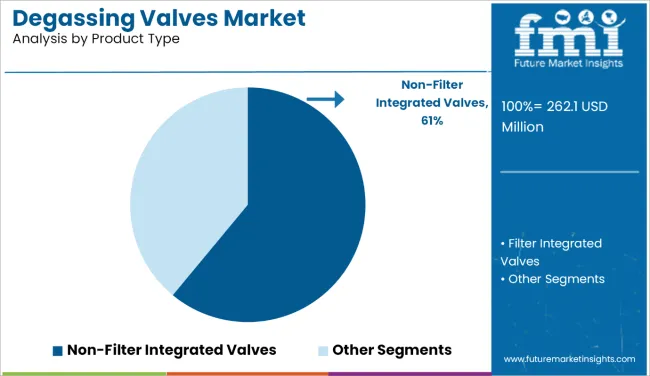
One-way degassing valve segment is estimated to account for 56% of the degassing valves market share in 2025. The segment's leading position stems from its fundamental role as a critical component in coffee packaging applications and its extensive use across multiple food processing sectors. One-way valve's dominance is attributed to its superior gas release properties, including pressure control, aroma retention, and moisture protection capabilities that make it indispensable for freshness preservation operations.
Market Position: One-way degassing valve systems command the leading position in the degassing valves market through advanced gas release features, including comprehensive pressure management, extended freshness life, and reliable performance that enable processors to deploy advanced preservation solutions across diverse packaging environments.
Value Drivers: The segment benefits from processor preference for proven valve technology that provides immediate gas release without requiring complex packaging modifications. Reliable design features enable deployment in coffee roasting environments, food processing facilities, and specialty packaging applications where freshness and aroma represent critical quality requirements.
Competitive Advantages: One-way valve systems differentiate through rapid gas release capability, proven freshness performance, and compatibility with standard packaging systems that enhance product quality while maintaining cost-effective operational profiles suitable for diverse food applications.
Key market characteristics:
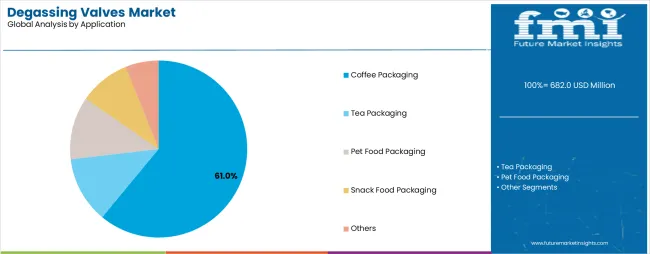
Coffee packaging segment is projected to hold 61% of the degassing valves market share in 2025. The segment's market leadership is driven by the extensive use of degassing valves in roasted coffee preservation, freshness maintenance, aroma protection, and package integrity, where valves serve as both a protective component and quality enhancer. The coffee industry's consistent demand for high-quality, reliable freshness preservation materials supports the segment's dominant position.
Market Context: Coffee packaging applications dominate the market due to widespread adoption of advanced valve materials and increasing focus on product quality management, flavor preservation, and freshness efficiency applications that enhance consumer satisfaction while maintaining product integrity.
Appeal Factors: Coffee roasters prioritize valve reliability, performance consistency, and integration with existing packaging infrastructure that enables coordinated deployment across multiple production systems. The segment benefits from substantial equipment budgets and modernization programs that emphasize quality enhancement for specialty coffee and premium products.
Growth Drivers: Specialty coffee market expansion incorporates degassing valves as standard components for freshness preservation and aroma protection applications. At the same time, retail packaging initiatives are increasing demand for high-quality valve systems that comply with food safety standards and enhance product shelf life.
Market Challenges: Packaging requirements and equipment compatibility issues may limit deployment flexibility in certain production types or existing infrastructure scenarios.
Application dynamics include:
Growth Accelerators: Packaging modernization drives primary adoption as degassing valve systems provide reliable gas release capabilities that enable freshness preservation without manual intervention, supporting food safety compliance and operational efficiency that require precise quality management. Consumer demand accelerates market expansion as processors seek effective freshness solutions that minimize staleness costs while maintaining flavor standards during storage and distribution operations. Coffee consumption increases worldwide, creating demand for advanced valve systems that complement traditional packaging materials and provide operational flexibility in complex food processing environments.
Growth Inhibitors: Application complexity challenges vary across product types regarding packaging integration and performance requirements, which may limit deployment flexibility and market penetration in facilities with restrictive equipment modifications. Technical performance limitations persist regarding extreme temperature applications and humidity exposure that may increase operational costs in demanding environments with frequent climate variations. Market fragmentation across multiple food safety codes and performance standards creates compatibility concerns between different valve manufacturers and existing packaging infrastructure.
Market Evolution Patterns: Adoption accelerates in specialty coffee and premium food sectors where advanced freshness preservation justifies material costs, with geographic concentration in developed markets transitioning toward mainstream adoption in emerging economies driven by packaging modernization and consumer awareness development. Technology development focuses on enhanced gas release capabilities, improved pressure regulation, and integration with quality management systems that optimize production scheduling and freshness monitoring. The market could face disruption if alternative preservation technologies or regulatory restrictions significantly limit degassing valve deployment in food packaging or commercial applications.
The degassing valves market demonstrates varied regional dynamics with Growth Leaders including China (5.9% CAGR) and India (5.6% CAGR) driving expansion through coffee consumption growth and packaging infrastructure development. Steady Performers encompass the USA (5.4% CAGR), Brazil (5.2% CAGR), and Germany (4.6% CAGR), benefiting from established coffee markets and advanced packaging adoption.
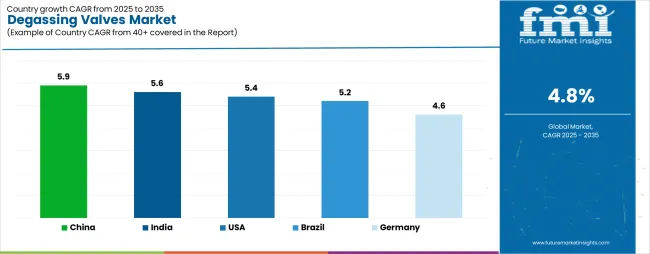
| Country | CAGR (2025-2035) |
|---|---|
| China | 5.9% |
| India | 5.6% |
| USA | 5.4% |
| Brazil | 5.2% |
| Germany | 4.6% |
Regional synthesis reveals Asia-Pacific markets leading growth through coffee consumption expansion and packaging infrastructure development, while Latin American countries maintain steady expansion supported by coffee production excellence and export market requirements. North American and European markets show strong growth driven by specialty coffee applications and premium packaging integration trends.
China establishes regional leadership through explosive coffee consumption growth and comprehensive packaging infrastructure development, integrating advanced degassing valve systems as standard components in specialty coffee and premium food applications. The country's 5.9% CAGR through 2035 reflects consumer lifestyle changes promoting coffee culture and domestic roasting capabilities that mandate the use of advanced freshness preservation systems in retail and food service operations. Growth concentrates in major urban centers, including Shanghai, Beijing, and Shenzhen, where coffee shop expansion showcases integrated valve systems that appeal to quality-conscious consumers seeking premium beverage experiences and freshness assurance.
Chinese packaging manufacturers are developing cost-effective degassing valve solutions that combine domestic production advantages with advanced features, including multi-pressure release systems and extended freshness capacity.
Strategic Market Indicators:
The Indian market emphasizes growing coffee consumption patterns, including rapid café expansion and comprehensive retail infrastructure development that increasingly incorporates degassing valves for specialty coffee and premium tea packaging applications. The country is projected to show a 5.6% CAGR through 2035, driven by urbanization trends under economic development programs and consumer demand for quality beverages with reliable freshness systems. Indian coffee roasters prioritize freshness effectiveness with degassing valves delivering consistent performance through advanced gas release properties and packaging versatility capabilities.
Technology deployment channels include major packaging suppliers, specialized coffee equipment companies, and retail procurement programs that support professional integration for growing roasting operations.
Performance Metrics:
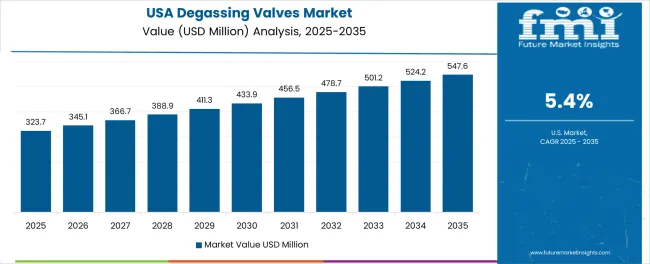
The USA market emphasizes advanced degassing valve features, including precision gas release systems and integration with comprehensive packaging platforms that manage freshness preservation, production scheduling, and quality tracking applications through unified food processing systems. The country is projected to show a 5.4% CAGR through 2035, driven by specialty coffee market expansion under consumer preference shifts and commercial demand for reliable, advanced freshness systems. American coffee roasters prioritize product quality with degassing valves delivering consistent performance through advanced material formulations and freshness monitoring capabilities.
Technology deployment channels include major packaging distributors, specialized coffee equipment providers, and roaster procurement programs that support professional integration for complex production operations.
Performance Metrics:
In São Paulo, Minas Gerais, and Espírito Santo, Brazilian coffee producers and roasting companies are implementing advanced degassing valve systems to enhance export quality capabilities and support international compliance that aligns with food safety requirements and freshness protocols. The Brazilian market demonstrates growth with a 5.2% CAGR through 2035, driven by coffee production excellence programs and export market requirements that emphasize advanced packaging systems for specialty and commercial applications. Brazilian coffee facilities are prioritizing degassing valve systems that provide reliable freshness preservation while maintaining compliance with international standards and minimizing quality degradation, particularly important in premium coffee exports and specialty roasting operations.
Market expansion benefits from coffee industry excellence programs that mandate high-quality packaging in production facility specifications, creating demand across Brazil's coffee producing and roasting sectors, where product quality and export competitiveness represent critical requirements.
Strategic Market Indicators:
The advanced food packaging market in Germany demonstrates sophisticated degassing valve deployment, growing at a 4.6% CAGR, with documented freshness effectiveness in specialty coffee and premium tea applications through integration with existing packaging systems and quality control infrastructure. The country leverages engineering expertise in packaging technology and precision manufacturing to maintain market leadership. Processing centers, including Hamburg, Munich, and Berlin, showcase premium installations where degassing valve systems integrate with comprehensive packaging platforms and quality management systems to optimize product freshness and operational effectiveness.
German food processors prioritize system reliability and material standards in valve development, creating demand for premium valve systems with advanced features, including enhanced pressure control and integration with automated packaging systems. The market benefits from established food processing infrastructure and willingness to invest in advanced packaging technologies that provide long-term quality benefits and compliance with food safety regulations.
Market Intelligence Brief:
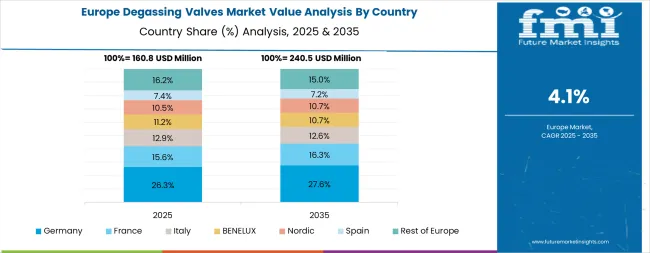
The degassing valves market in Europe is projected to grow from USD 202 million in 2025 to USD 321 million by 2035, registering a CAGR of 4.7% over the forecast period. Germany is expected to maintain its leadership position with a 31.8% market share in 2025, declining slightly to 31.4% by 2035, supported by its advanced food processing infrastructure and major coffee markets, including Bavaria and North Rhine-Westphalia.
Italy follows with a 24.3% share in 2025, projected to reach 24.6% by 2035, driven by comprehensive coffee culture and specialty roasting excellence initiatives. France holds a 19.2% share in 2025, expected to maintain 19.4% by 2035 through established café sectors and packaging technology adoption. The United Kingdom commands a 14.7% share, while Spain accounts for 7.4% in 2025. The Rest of Europe region is anticipated to gain momentum, expanding its collective share from 2.6% to 2.9% by 2035, attributed to increasing coffee consumption in Nordic countries and emerging Eastern European specialty coffee markets implementing advanced packaging programs.
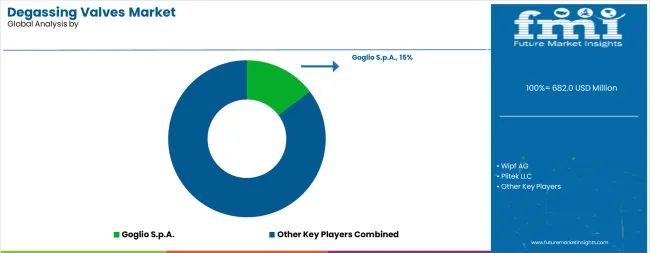
The degassing valves market operates with moderate concentration, featuring approximately 15-22 participants, where leading companies control roughly 45-50% of the global market share through established packaging relationships and comprehensive product portfolios. Competition emphasizes advanced gas release capabilities, material reliability, and application versatility rather than price-based rivalry.
Market Leaders encompass Goglio S.p.A., Wipf AG, and Plitek LLC, which maintain competitive advantages through extensive valve engineering expertise, global distribution networks, and comprehensive packaging integration capabilities that create customer loyalty and support premium pricing. These companies leverage decades of food packaging experience and ongoing research investments to develop advanced degassing valve systems with enhanced gas release and freshness preservation features.
Technology Challengers include CCL Industries Inc., Syntegon Technology GmbH, and TricorBraun, which compete through specialized valve technology focus and innovative design interfaces that appeal to food processors seeking advanced freshness capabilities and operational flexibility. These companies differentiate through rapid product development cycles and specialized coffee packaging application focus.
Market dynamics favor participants that combine reliable valve materials with advanced packaging support, including technical guidance and quality monitoring capabilities. Competitive pressure intensifies as traditional packaging manufacturers expand into degassing valve systems. At the same time, specialized component companies challenge established players through innovative gas release solutions and cost-effective products targeting specialized food packaging segments.
| Item | Value |
|---|---|
| Quantitative Units | USD 682 million |
| Product Type | One-Way Degassing Valve, Two-Way Degassing Valve, Specialty Valve |
| Application | Coffee Packaging, Tea Packaging, Pet Food Packaging, Snack Food Packaging, Others |
| Regions Covered | North America, Europe, Asia Pacific, Latin America, Middle East & Africa |
| Countries Covered | USA, Germany, Brazil, China, India, and 25+ additional countries |
| Key Companies Profiled | Goglio S.p.A., Wipf AG, Plitek LLC, CCL Industries Inc., Syntegon Technology GmbH, TricorBraun |
| Additional Attributes | Dollar sales by product type and application categories, regional adoption trends across North America, Europe, and Asia-Pacific, competitive landscape with valve manufacturers and packaging suppliers, processor preferences for freshness and quality performance, integration with packaging automation platforms and quality systems, innovations in gas release technology and application efficiency, and development of multi-functional solutions with enhanced preservation and monitoring capabilities |
The global degassing valves market is estimated to be valued at USD 682.0 million in 2025.
The market size for the degassing valves market is projected to reach USD 1,089.9 million by 2035.
The degassing valves market is expected to grow at a 4.8% CAGR between 2025 and 2035.
The key product types in degassing valves market are one-way degassing valve, two-way degassing valve and specialty valve.
In terms of application, coffee packaging segment to command 61.0% share in the degassing valves market in 2025.






Full Research Suite comprises of:
Market outlook & trends analysis
Interviews & case studies
Strategic recommendations
Vendor profiles & capabilities analysis
5-year forecasts
8 regions and 60+ country-level data splits
Market segment data splits
12 months of continuous data updates
DELIVERED AS:
PDF EXCEL ONLINE
Degassing Valves Industry Analysis in United States & Canada - Size, Share, and Forecast 2025 to 2035
Assessing Degassing Valves Market Share & Industry Trends
Slurry Valves Market Analysis - Size, Share, and Forecast 2025 to 2035
Market Share Breakdown of Aerosol Valves Industry
Aerosol Valves Market Growth and Trends 2025 to 2035
Pigging Valves Market
Blow-Off Valves Market Growth – Trends & Forecast 2025 to 2035
Isolator Valves Market
Aerospace Valves Market Growth - Trends & Forecast 2025 to 2035
Butterfly Valves Market Analysis by Type, Mechanism, Function, Applications, and Region through 2035
Cryogenic Valves Market Growth - Trends & Forecast 2025 to 2035
Automotive Valves Market Size and Share Forecast Outlook 2025 to 2035
Anti Siphon Valves Market Analysis - Size, Share, and Forecast Outlook 2025 to 2035
Surgical Heart Valves Market Size and Share Forecast Outlook 2025 to 2035
Thermal Mixing Valves Market Size and Share Forecast Outlook 2025 to 2035
Stand-Up Pouch Valves Market Size and Share Forecast Outlook 2025 to 2035
Chassis Leveling Valves Market Growth - Trends & Forecast 2025 to 2035
Automatic Gearbox Valves Market Growth - Trends & Forecast 2025 to 2035
Railway Emergency Valves Market Trends and Forecast 2025 to 2035
Electronic Expansion Valves Market Size and Share Forecast Outlook 2025 to 2035

Thank you!
You will receive an email from our Business Development Manager. Please be sure to check your SPAM/JUNK folder too.
Chat With
MaRIA